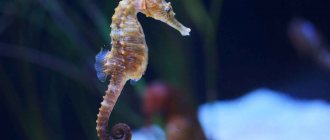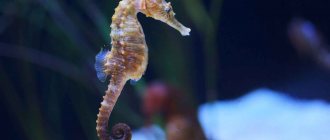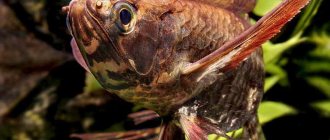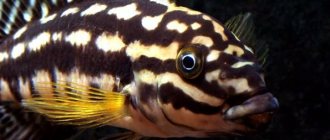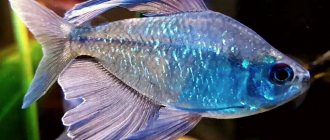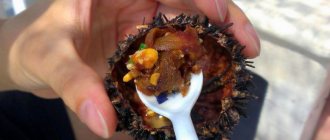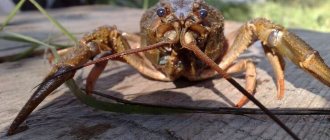Here we have collected a lot of information about the anglerfish - a mysterious inhabitant of the depths, the monkfish. Life at great depths did not provide the opportunity to study this interesting inhabitant of the seas in detail. It is now known that the formidable monster is distinguished by its repulsive appearance, unusual method of hunting and the strange relationship of the male with the female.
| Full name | Anglerfish - Anglerfish Scientists call it: Lophius (Lofius) |
| Types (number) | There are 120 species, of which: ● 17 – smooth-fronted anglerfish; ● 1 – blackmouth; ● 7 – monkfish; ● 3 – sweets and other types. |
| Color | The back is brown, with a green-brown or red tint. Body with dark spots to camouflage on the bottom. The belly is white. |
| Water | Sea cool |
| Feed | Females eat: ● crustaceans and cephalopods; ● gerbils; ● small stingrays and sharks; ● cod and eel; ● flounder, herring and mackerel, sometimes birds. Males, to the point of parasitism, feed on crustaceans and chaetognaths. |
| At what depth does it live? | Adult sea devils descend to 20-700 m. Some live at a depth of 1.5–3 km, sometimes 5. |
| Compatibility | They are kept separately in the aquarium. There are few enemies in nature; most often they are larger fish and shellfish. |
| Lifespan | Long-lived - deep-sea monkfish, lives 3 decades. Black-bellied anglerfish - 20 years, Cape monkfish - 10 years. |
Sea devils - description
| Class: | Ray-finned fish |
| Squad: | Anglerfishes |
| Family: | Anglerfish |
| Genus: | Anglerfish |
| View: | European anglerfish |
| Scientific name: | Lophius piscatorius |
Due to its deep-sea habitat, this species is poorly studied. It is also called the sea scorpion or fishing frog due to its special fishing rod on its head.
Photo: monkfish with prey in its mouth
Scientists suggest that the first monkfish appeared more than 100 million years ago. Their specific appearance is due to a long period of adaptation to deep-sea habitat conditions.
Some people believe that monkfish and anglerfish are two completely different fish. In fact, when they talk about monkfish, they mean a specific species - the European anglerfish. It is not so scary in appearance and is what is most often eaten. It is found at a depth of 200-250 m. But deeper-sea species are caught much less frequently. But both of them belong to the same group.
Anglerfish and people
Hunting for people is not a vital necessity for anglers; it is not his style. But a person can actually get wounded if he gets stuck on a monkfish thorn.
Carp fish - description, main types, useful properties, habitats, catching + 78 photos- Loach - fish lifestyle, nutrition, reproduction process + 71 photos
Pike - appearance, habitats, nutrition, varieties, spawning + 86 photos
However, to the most annoying visitors, he can show his sharp teeth in practice, dashingly grabbing the curious one.
In America and some European countries, the restaurant business uses anglerfish meat as a delicacy that tastes like lobster. In Asian countries, monkfish is used in cooking. Because of this, there is a real hunt for such a creepy-looking fish.
What does monkfish look like?
Females have the characteristic appearance of monkfish. Depending on the species, the appearance of the fish may differ, but the main characteristics are the same:
Photo: caught anglerfish
- bare skin that has growths but no scales;
- flattened body with a wide head;
- “fishing rod” - the front part of the dorsal fin with a flashlight at the end.
The species received its name from the Spanish conquistadors more than 500 years ago, when they first caught this fish. They were so amazed by her appearance that they were sure that they had caught the sea devil himself.
Photo: monkfish in water
The skin of an anglerfish has growths that are very similar in appearance to the bottom and algae. The skin can hang down like a fringe, merging with the bottom soil. The color of the monkfish is motley, similar to bottom sand.
- Fish grow up to 2 m in length and weigh up to 60 kg.
- The predator's mouth is lined with sharp teeth, sometimes in 2 rows, and the lower jaw is usually pushed forward.
- The eyes are small, see very poorly, and are located quite far from each other. At its usual habitat depth, vision is of little use to this fish. Constant darkness allows this fish to hide well, but also hides potential prey and males from it.
- It has another interesting adaptation - illium. That’s what her “fishing rod” is called. At the end of the illium there is an escu - a sac with luminescent bacteria. The fish can control its “lantern” and turn it on only when necessary. Light in such pitch darkness makes it easy to attract prey. And the huge mouth and razor-sharp teeth are capable of swallowing an opponent who is even larger than the devil himself.
Features of procreation
Male anglerfish are much smaller in size. To fertilize eggs, they need to find a mate and not miss her, so they literally bite into her forever.
After some time, they grow into each other, forming a single whole, as a result of which part of the male’s organs dies. Nutrients are transferred through the blood from the female.
The angler-husband only needs to fertilize the eggs at a certain point.
During the sexually mature period, to procreate, female anglerfish descend to depths of almost 2000 m to lay eggs. A female anglerfish can lay a clutch of approximately 3 million eggs, which forms a wide ribbon of about 10 m with cells in the form of hexagons (honeycombs).
After some time, these so-called honeycombs are destroyed. As a result, the eggs become free and are carried in all directions by currents.
A few days later, tiny larvae are born from the eggs, and after 4 months they are already fry. The fry, 6 cm long, independently sink to the bottom of shallow water.
Species of monkfish
The anglerfish family is quite diverse. But the most popular and widespread are 5 types of monkfish:
American monkfish
Reaches a length of 90 cm, weighs up to 22 kg. Among angler fishermen it is rightfully considered a long-liver. Life expectancy is up to 30 years. It is currently endangered due to overfishing. It lives in the waters of the northwestern Atlantic at depths of up to 670 m.
Black-bellied anglerfish
Smaller than the American one, it grows 50 cm in length, although sometimes specimens up to 1 m are found. Life expectancy is 20 years. Found in the eastern Atlantic, Mediterranean and Black Seas. The usual depth is from 300 to 650 m.
Western Atlantic anglerfish
Reaches 60 cm, lives in the western waters of the Atlantic Ocean, as its name suggests. The main share of the catch belongs to Brazil.
Far Eastern monkfish
Reaches a length of 150 cm. Lives in the Sea of Japan. This species is the deepest of those listed - it is found at depths of up to 2000 m. It is also a popular commercial fish.
European anglerfish (Lophius piscatorius)
A real record holder among his brothers. Body length up to 2 m, weight up to 57 kg. It lives in the Atlantic Ocean at a depth of up to 550 m. It is mined in England and France.
The nutritional value
Vitamins
- PP Vitamin PP (NE) 4.1568 mg
- E (TE) Vitamin E (TE) 0.5 mg
- B1 Vitamin B1 0.09 mg
- A (RE) Vitamin A (RE) 30 mcg
- PP Vitamin PP 1.7 mg
- A Vitamin A 0.03 mg
Macronutrients
- Ni Nickel 6 mcg
- Co Cobalt 20 mcg
- Mo Molybdenum 4 µg
- F Fluorine 430 mcg
- Cr Chromium 55 mcg
- Mn Manganese 0.05 mg
- Cu Copper 60 mg
- I Iodine 50 mcg
- Zn Zinc 0.7 mg
- Fe Iron 0.9 mg
Where does the anglerfish live?
The habitat of the monkfish is quite large. Representatives of this species can be found in the depths of the eastern Atlantic Ocean, the Black and Mediterranean seas. It is mined in the waters of the Sea of Japan, the North and Baltic Seas, as well as in the Okhotsk and Yellow Seas.
The sea anglerfish stays closer to the bottom, at a depth of 200-250 m and below. Larger individuals can go to depths of up to 2 km. During periods of prolonged hunger or immediately after spawning, many individuals rise higher, go into shallow water and even hunt birds.
Habitat
The habitat of this fish is considered to be the Atlantic Ocean. The anglerfish is found off the coast of Europe, off the coast of Iceland. In addition, monkfish have been found in the waters of the Baltic Sea, Black Sea, North Sea and Barents Sea.
The depth at which these fish usually live is from 50 to 200 meters. Most often they are found at the very bottom, because there is nothing more pleasant for monkfish than just lying quietly on sand or silt. But it is only at first glance that the angler fish is idle. In fact, this is one of the ways of hunting. The animal freezes, waiting for its prey. And when it swims by, it grabs it and eats it.
What does an anglerfish eat?
All anglerfish are predators. They eat all living creatures that come their way: fish, deep-sea squid, shrimp, even waterfowl. Their stomach is dimensionless, and their hunger is almost insatiable.
Sea devils are very voracious. Their stomach allows them to swallow prey that can exceed the size of the fish itself. Fishermen say that if a monkfish gets into the net along with another catch, then it is able to eat all the rest of the fish.
But the structure of the jaw is such that the monkfish cannot spit out its prey. The sharp teeth are curved towards the mouth, and in some species such teeth grow not only above and below, but also in two rows. When the mouth opens, low pressure is created, creating a vacuum that literally sucks the victim in. Therefore, without calculating the strength and without comparing the sizes, the monkfish often dies by choking on an overly large meal or bird feathers.
Some interesting facts about the sea devil
- Monkfish reaches a length of up to 2 meters and weighs more than 50 kg
- The monkfish's body is so flexible, its mouth is so large, and its stomach is so stretchable that it can swallow prey twice its own size.
- When the prey swims up to the hunter, he instantly opens his mouth and sucks it in along with the water.
- The monkfish lives in the dark at the bottom, and on the head of the fish there is a “flashlight” at the tip of the “fishing rod”. The fish’s “flashlight” serves as bait, to which other fish react and swim closer to be eaten by the sea devil.
Sources:
https://animalssea.ru/ryby/morskoj-chert/morskoj-chert.shtml
https://webnewsite.ru/morskoy-chert-ili-udil-schik-obychnyy-interesnye-fakty/
Natural enemies
Monkfish have almost no natural enemies. Their appearance allows them to carefully camouflage themselves at any bottom, and their gluttony and cunning hunting allow them to defeat opponents that are larger than them. In addition, at the depths in which the angler fish prefers to live, there are quite few inhabitants. The anglerfish rarely encounters large sea predators, but it can defeat all small ones without much damage, since it is at the top of the food chain.
The anglerfish is not of particular nutritional value for marine life, since the bulk of its body mass is in its head and huge mouth. Not a single inhabitant of the depths purposefully hunts him.
Anglerfish with an open mouth
The enemies of the anglerfish are considered to be giant squids, large octopuses and dragon fish, isopods, goblin sharks and “hell vampire” mollusks. Quite large anglerfish were found in the stomachs of these marine inhabitants.
The main damage to the population comes from the consumption of tadpoles and eggs by whales, sharks and other marine fish. Anglerfish do not protect their young, and therefore they drift into the waters, left to the whims of fate.
The main enemy of monkfish can be considered the person who catches it on an industrial scale. More than 30 thousand tons of this marine life are caught annually. In countries such as Brazil or France, the catch is put on stream, and the products are also exported to other countries.
Far from being a beauty
Even adults can be frightened by angler fish, or their appearance can be used as a basis to create a particularly creepy monster movie. This sea creature has an appearance that is the complete opposite of ideas about harmony and beauty : the spherical body is disproportionate, with the head taking up most of it. The lower jaw protrudes forward, the mouth is huge, and when the fish opens it, sharp needle-like teeth curved inward are visible. But not only this can cause panic. Around the mouth there are leathery folds that constantly move, and instead of scales, the naked body is covered with spines. The skin itself is rough and warty. The fish has small eyes, but when it is lifted from the depths, it experiences excess pressure, so the eyes become bulging and the body is swollen.
Features of character and lifestyle
Sea devils are significantly different from other representatives of the animal world. This is manifested not only in appearance and method of hunting. Thus, sexual parasitism is common among anglerfish, and males are so different from females that some time ago they were classified as different species. There was even a theory that anglerfish are hermaphrodites. But in reality everything is much more complicated.
Reproduction and offspring
The reproduction process of monkfish can amaze no less than their appearance. Males search for a female by smell. Their sizes are simply incomparable in relation to each other, and therefore they reproduce in a very non-standard way.
- The male chooses a female for himself, then attaches himself to her and gradually loses himself, becoming literally one with her - he begins to feed at her expense, gradually loses his organs, becoming just a shoot with a single fertilizing function.
- For a successful suction process, it is important for the male to choose the right position to approach the female. Potential brides have very poor vision, and therefore may inadvertently eat the future groom.
Different species of anglerfish are ready to spawn at different ages. For some, this occurs almost immediately after transformation from a tadpole, while for others, for example, the European anglerfish, the appropriate age occurs only at the age of 14.
Female anglerfish and male
For spawning, which occurs in the spring, anglerfish often go to greater depths than usual. During one spawning, the female is capable of producing up to 3 million eggs. The caviar is spawned in the form of a long and wide ribbon. The size of the eggs can reach 4 mm. Females do not keep track of the eggs. They mark her and swim away. After a few days, the eggs turn into tadpoles, which feed on plankton. After 4 months, defenseless fry are able to settle to depth on their own.
Certain species of deep-sea anglerfish spawn in certain secluded places. Males fertilize the eggs at the spawning site. In the same way, fish do not monitor their offspring and do not protect them.
Male parasitism
Anglerfish are known for their sexual parasitism. And this process has hardly been studied by modern scientists. They know for sure that the male parasitizes the female, becoming her appendage. And there can be up to six such parasites on one fish at a time. Moreover, if the male has not found a female, he dies very quickly.
Female anglerfish and several males
Males have more developed vision and hearing, but nevertheless they are not able to survive without a female. Males bite into the female’s body, feed on her nutrients, gradually acquiring blood vessels.
There is a theory that the monkfish fish has some kind of alternative version of immunity, which gives it the opportunity not to reject the attached parasite, but to accept it and allow it to germinate.
Features not related to reproduction
A deep fish with a fishing rod on its head has many other differences from the usual inhabitants of the water.
- For example, she does not have a swim bladder. It allows other representatives of aquatic flora not to drown under their own weight. But the angler fish lives at sufficient depths that it simply does not need such an organ.
- Another feature that is of great interest to scientists is where the luminescent bacteria that live in its “fishing rod” come from in fish. There are two theories. According to the first, the eggs are received by bacteria from the mother. The second theory is that females simply encounter these bacteria while they swim.
- The glow occurs with different intensities. There may be flashes, increased or decreased glow. Scientists have not yet been able to study this point either. It is believed that this may be related to blood supply and the amount of oxygen.
Diseases and prevention
Marine aquarium fish easily pick up infections that are spread by viruses, fungi and bacteria. When infected with viruses, fish suffer from viral necrosis of erythrocytes or lymphocystis. The appearance of dangerous bacteria causes disease:
- furunculosis
- aeromonosis
- pseudomonosis
- Edward's disease
- Tuberculosis
- streptococcosis
- vibriosis;
- myxobacteriosis.
The appearance of parasites causes disease:
- oodinosis;
- cryptobiosis;
- brooklynellosis;
- cryptokaryosis or trichodinosis.
To prevent infection, you should carefully monitor that pathogens do not enter the aquarium. To do this, you need to properly care for the inhabitants and their home, monitor the temperature and composition of the water. Do cleaning in a timely manner, change the water, and feed the fish correctly.
How long do anglerfish live?
The length of the life cycle varies depending on the species. Thus, the European monkfish can live on average 17-20 years. The American angler lives much longer - about 30 years, and the Cape one - no more than 10 years.
Anglerfish head
The lifespan of a monkfish depends on many factors: the amount of food, what it actually gets to eat, and what it catches by humans.
Does the anglerfish pose a danger to people?
This predatory fish does not pose a real threat to humans.
Firstly, a person rarely gets to the depths familiar to an angler, being at least without protection (a bathyscaphe or a spacesuit).
Angler fish skeleton model
Secondly, even a very voracious devil will not be able to eat an entire adult without choking.
However, the sharp teeth of this fish can cause serious injury to the limb. After spawning, many anglerfish rise closer to the surface of the water to feed. There are known cases when scuba divers encountered the devil in shallow water. And in 2013, a video appeared in which an angler grabbed an underwater hunter by the hand (but this happened more likely after the fish was taken out of the water).
Male parasitism
Of all the diversity of the animal world, parasitism of males is characteristic only of the angler fish. Of the eleven families of anglerfish, four are susceptible to this parasitism, namely:
- Caulofrines;
- Linofrine;
- Ceratiaceae;
- Novoceratiaceae.
Possessing good eyesight and sense of smell, males detect the female by emitted pheromones, which persist for a long time in the still water column. To determine whether a female belongs to their species, males visually evaluate the shape of the fishing rod and the frequency of flashes, which varies among all species. Having made sure that the female is of the same species, the male swims up to her and tightly clings to her side with his teeth.
Having attached itself to the female, the male anglerfish loses its independence. After some time, it fuses with the female’s tongue and lips. Its organs atrophy, in particular, the eyes, teeth, jaws, olfactory organs, fins, and stomach. He becomes one with the female, feeding himself through a system of common blood vessels.
Up to six males can parasitize a female's body. Eventually, they turn into simple appendages that perform the sole function of producing sperm. At the right moment, males just need to fertilize the eggs.
A valuable commercial fish, they are caught with bottom trawls, gill nets and bottom longlines.
Features of keeping in an aquarium
A specific type of anglerfish from the clown anglerfish family is most often kept in aquariums. Their size does not exceed 20 cm. The main requirement for their maintenance is the absence of neighbors. Even small sea devils remain voracious predators and masters of camouflage. Therefore, any fish in the neighborhood will have no chance of survival.
Anglerfish do not control their appetite, and therefore it is very important to choose the feeding rate. They die from overfeeding and wither away from hunger. They only eat live fish. It is almost impossible to get used to frozen food or seafood. Optimal conditions for keeping one fish: 250-300 liters of water with a temperature of 24 to 27 degrees.
Maintenance and care
It is recommended to keep small specimens of monkfish in aquariums, such as fish that belong to the clown family.
Striped clown
In nature, their home is the subtropical and tropical waters of the Atlantic, Pacific and Indian oceans. The average size of the fish is 20 cm, there are small ones of 5 cm and giants up to 45 cm. Shades of yellow, red, brown and black with spots of dark or light color. These fish walk along the bottom because they cannot swim - they do not have a swim bladder.
Content Features
Clowns, like other devils, are recommended to live alone in separate aquariums so as not to eat their neighbors. Or so that they do not damage the sensitive outgrowths of predators. You should choose a container of 20 liters, maintain the water temperature no lower than 24 and no higher than 27 degrees. The acidity level should be 8.0-8.5, salinity - from 1.02 to 1.025.
Anglerfish are sensitive to water conditions, so even small inconsistencies can kill an anglerfish.
The aquarium is decorated with artificial reefs and coral protrusions. Loose soil and pebbles are poured onto the bottom.
Equipment
To keep marine fish, the aquarium must be properly organized and equipped with special equipment. When preparing the tank, pay attention to hardness, salinity, lighting, water circulation and the presence of oxygen in the water.
Lighting is controlled by lamps with different spectral and power indicators. Water circulation will be ensured by a flow pump. Using a scrubber, water is purified, and carbonate hardness is increased with a calcium reactor or equipment is used for the balling method. Replenish calcium and carbonates in water with a solution of kalkwasser.
Foam is used to remove foam from the surface of the water, first passing it through filters so that it does not smell.
What and how to feed
Aquarium anglerfish feed on fresh fish; it is allowed to feed them with crustaceans and cephalopods. It is difficult to feed with frozen foods or specialized food; the monkfish does not accept this food. In addition, each fish is given the right amount of food, because the voracious inhabitants can easily overeat.
When releasing live food, it is interesting to watch the predator hunt. At first, the sea devil hides, camouflages itself, and lures prey by moving the fishing rod's flashlight. The angler instantly sucks up the fish that swims up or attacks, making a jump.
Interesting fact: a vacuum is created in the opened mouth, and food, along with water, is sucked inside.
Sometimes females swallow prey 3 times larger than their own body. Having choked, he cannot push it out, because his teeth, bent inward, are in the way. Having suffocated, the glutton dies.
How long does he live?
Anglerfish species live differently, but the average lifespan is 15 years:
- The American monkfish is considered to be a long-liver; it lives for 30 years;
- the black-bellied anglerfish manages to live in the wild for 20 years;
- Cape monkfish – 10.
In addition to belonging to the species, lifespan is affected by water, and in captivity, care. They do not live in aquariums for a long time because they cannot adapt to captivity.
Interesting Facts
- The anglerfish can move along the bottom surface by jumping. Its pectoral fins are so developed that they allow it to push off and make sharp jumps. Most often, this skill is used during hunting for a sharp and unexpected attack on prey.
- At the bottom the pressure reaches almost 300 atmospheres. Therefore, when a monkfish is raised to the surface, its body changes: the fish swells, and its eyes seem to be popping out of their sockets.
- Male monkfish have an excellent sense of smell. They look for a female, focusing not only on her appearance, but also on her smell. Females secrete special pheromones. And their fishing rods differ depending on the specific species. This landmark also helps males search for suitable individuals.
- In some species of monkfish, the length of the fishing rod can exceed the size of the fish itself by 4 times. Such anglerfish are called gigantaxis.
- A species of devil called the Greenland ceratia can not only turn off its “lantern”, but also fold it. There is a special hole in their back into which the fishing rod is simply retracted when not needed.
Angler on board a fishing boat
Nutrition and reproduction
They prefer to hunt other deep-sea fish. Often their prey is representatives of the orders Gonomostomera, Melamphaidae or Howlidae.
Sometimes the anglerfish hunts crustaceans, feeds on mollusks or cuttlefish or small squid.
The difference between fish, in terms of hunting reflexes, is a high level of gluttony. They often attack prey that is several times larger than their own body size. True, such a result of the hunt most often ends disastrously for the devil fish itself. She simply dies from choking on her prey. She can no longer spit out because of her teeth that are bent back.



